The Simple & Easy Process Of Making Homemade Sauerkraut
Learn how to make homemade sauerkraut with my foolproof sauerkraut recipe, plus useful tips and advice to help you make it at home.
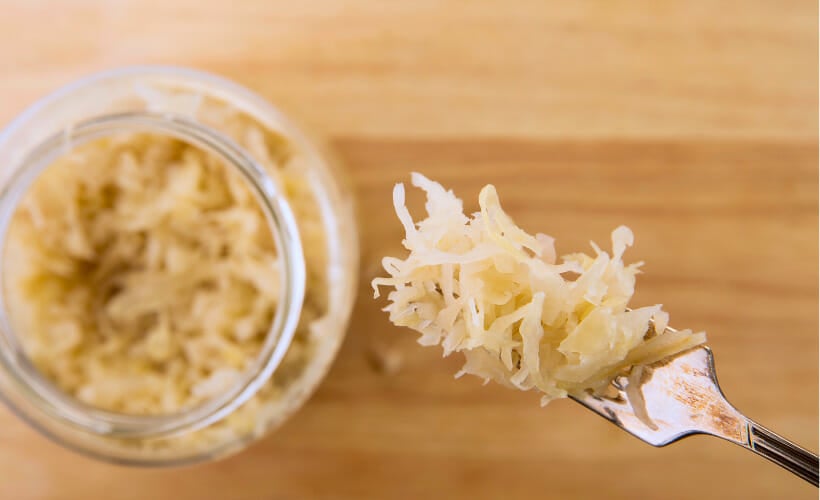
Sauerkraut is not only tasty but also has incredible health benefits. This fermented food is packed with probiotics, vitamins, and minerals that can have a host of benefits for your health. The probiotics in sauerkraut can help to boost digestive health, maintain a healthy balance of beneficial bacteria in the gut, and even reduce inflammation. Additionally, vitamins and minerals like vitamin C, magnesium, and calcium can boost nutrient intake and support your immune system. With its rich nutritional profile, sauerkraut is an easy and delicious way to incorporate important vitamins and minerals into your diet.
Sauerkraut can also support weight loss, improve digestion, and promote a healthy heart. It contains fiber, which can help you feel fuller for longer and aid in weight management. The fermentation process also breaks down the fiber in cabbage, making it easier to digest.
Furthermore, sauerkraut is low in calories and fat, making it a nutritious choice for those watching their weight. Additionally, studies have shown that the lactic acid in sauerkraut can help reduce cholesterol levels, which is beneficial for heart health.
If you want to try making your own sauerkraut at home but aren’t sure where to start, this guide is for you. I’ll show you exactly how to make sauerkraut from scratch, helping you to master this traditional food without the worry of getting it wrong. You’ll need some basic supplies and tools to get started, but the good news is you probably already have most of them in your kitchen. Plus, with our tips and advice, you can make your own sauerkraut with confidence. So, grab your fermentation jar and your salt shaker, and let’s get started!
Are sauerkraut and kimchi the same thing?
No, sauerkraut and kimchi are not the same. Sauerkraut is a type of German pickled cabbage, usually made from white cabbage. It is fermented in a brine mixture of salt and cabbage juice. Kimchi, on the other hand, is a Korean pickled spicy cabbage. It is made by fermenting vegetables such as cabbage, radish, or cucumber in a mixture of garlic, chili paste, fish sauce, and occasionally sugar. Kimchi is usually served as a side dish, while sauerkraut is more commonly used as an ingredient in salads and sandwiches.
What does sauerkraut taste like?
Sauerkraut has a distinct taste – a unique blend of sharp and salty. Its acidic flavor is attributed to fermentation, where the cabbage is exposed to lactic acid. Sauerkraut is a great addition to any meal – whether it’s mixed into rice, added to a sandwich, or served as a topping to a delicious hotdog. It’s a surefire way to take your lunch up a notch.
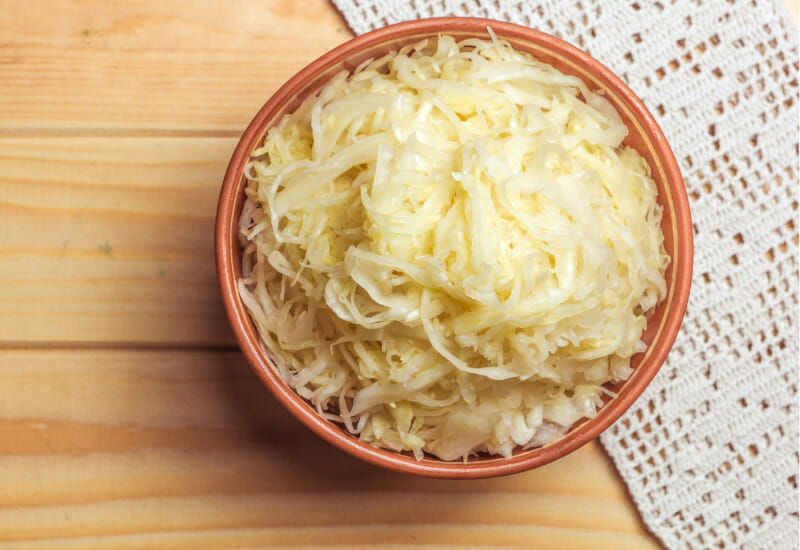
Is it better to eat sauerkraut raw or cooked?
Cooked sauerkraut can be more palatable than eating it raw. Fermentation creates a pungent odor and an aggressively sour flavor, which may be overpowering to eat in its raw state. Once cooked, the sourness mellows out, and the flavor can be adjusted to your individual taste preferences by adding herbs or spices. You may even choose to caramelize it with onions and apples for an extra boost of sweetness.
However, raw sauerkraut provides a more nutrient-dense experience, as it includes higher levels of pre- and probiotic bacteria, which can help boost your gut health and digestibility. Ultimately, which type of sauerkraut you choose will depend on your individual taste preferences and dietary needs.
Tools And Supplies You Need
You will need a few items if you are planning to make sauerkraut at home. Quart-sized mason jars with tight-fitting lids are essential to get started. This helps contain the fermentation process and ensures an air-tight environment in which to produce your kraut.
You will need a weight to keep the cabbage submerged in the brine and to help with fermentation. I purchased some fermentation weights that fit perfectly in my wide-mouth mason jars, but if you don’t have any of these on hand, Learning & Yearning has ten ideas for keeping your ferments submerged.
Amazon has a fermentation kit with fermentation lids, weights, a tamper, and a recipe book.
Disinfect Your Materials
It is important to remember to disinfect all necessary equipment before beginning. This means scrubbing any cutting boards, knives, and other tools with a disinfectant such as vinegar or bleach. Additionally, any containers that hold the sauerkraut should be cleaned and dried thoroughly to ensure they are free from bacteria.
After being disinfected, these tools should not come into contact with any unwashed surfaces or hands. Finally, the cabbage should be washed with cold water before being used in the recipe.
Following these simple steps can help ensure that your sauerkraut is always safe and delicious.
Preparing Your Cabbage & Brine
Ingredients
- A cabbage (approx. 2 lbs)
- 3-4 teaspoons of fine grind salt
Start your sauerkraut journey with a head of fresh cabbage. Danish Ballhead, Late Flat Head, and Premium Late Dutch are good cabbage varieties for sauerkraut. Weigh your cabbage and write down the weight to use later in calculating how much salt you’ll need.
Carefully peel off the outer leaves—these tend to be dirty or damaged, so they won’t be used.
Cut out the cabbage core and keep an extra outer leaf aside. Shred the cabbage and either manually chop it with a sharp knife or use a food processor.
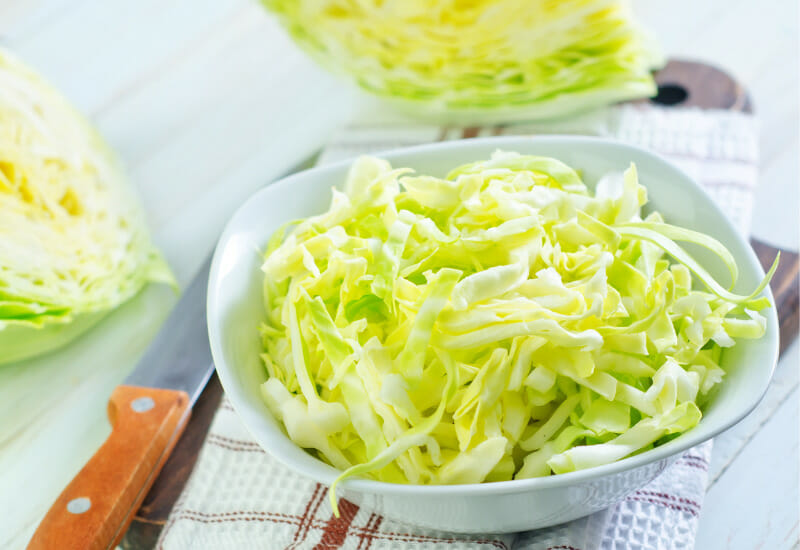
Now it’s time to determine how much salt you’ll need: use 2 teaspoons per pound if you enjoy salty sauerkraut or 1½ teaspoon per pound if you prefer a more subtle flavor. For instance, if your cabbage is 2½ pounds, add 3¾ to 5 teaspoons salt; if it’s 3 pounds, use 4 ½ to 6 teaspoons.
A fine grind of salt is required for sauerkraut. Sea salt works well, or rock salt. Watch out for the salt labeled ‘pickling salt’ because it often has anti-caking agents in it, which can negatively affect your fermentation.
Sprinkle your desired amount of salt over the cabbage and allow it to rest for 15 minutes, then massage it for 5 minutes to release its liquid and create the brine for the final fermentation.
Finally, it’s time to pack the jars and begin the sauerkraut process!
Pack The Jar
Fill the jar with approximately 4 to 5 handfuls of cabbage, pressing it down firmly to ensure a tight pack.
Slowly and evenly pour the liquid from the bowl onto the cabbage in the jar, making sure that the cabbage is completely covered. If the cabbage juice is not enough to cover the cabbage, you can mix together a 2% solution of salt water. This is equal to about 1 teaspoon of salt per cup of water. Note: If your tap water contains fluoride or chlorine, make sure to use filtered water instead.
Remember that cabbage leaf that you saved earlier? Cut a circle out of it the same size as the opening of your jar. Place the cabbage leaf directly on top of the shredded cabbage to act as a barrier, keeping the cabbage submerged under the brine. You want to weigh the cabbage down so that it stays below the brine. Keeping the cabbage weighed down and submerged under the brine helps to create an anaerobic environment, preventing the growth of harmful bacteria and molds.
Close The Lid & Ferment
Place the fermenting weight on top of the cabbage leaf, ensuring it is completely submerged in the liquid. Securely screw the lid onto your jar. Consider using a plastic lid instead of a metal one to avoid rusting.
Store the jars at 70-75° F while fermenting. At these temperatures, the sauerkraut will be ready in 3 to 4 weeks. At 60-65°F, fermentation may take 5 to 6 weeks. How long you ferment is really up to you. When determining if the sauerkraut is fermented to your liking, consider factors such as its taste, texture, and smell.
Keep an eye on your sauerkraut throughout the fermenting process. If the liquid in the jar gets too low, prepare a 2% salt water solution by dissolving 2 grams of salt in 100 ml of water. Add enough of this solution to bring the liquid level back up to cover the cabbage. If any scum forms on top of the liquid, skim it off.
Remove the weight and round cabbage leaf when your sauerkraut is fermented to your desired taste and texture.
Troubleshooting Homemade Sauerkraut

Store Your Sauerkraut
After fermentation is complete, make sure your sauerkraut is kept in a cool environment by storing the jar in the coldest part of the refrigerator.
How long does sauerkraut keep in the fridge once opened?
The short answer to this question is that sauerkraut will keep up to three to four weeks in the fridge after being opened. However, it’s important to keep an eye on the sauerkraut and use your senses to determine whether it has gone bad. If the sauerkraut smells weird or looks slimy, it’s best to discard it. Even if the sauerkraut doesn’t show any signs of spoilage, it’s important to give it a taste test before consuming it. It should be thrown away for safety reasons if it tastes off.
Can sauerkraut be frozen?
The answer to this question is yes. Sauerkraut can be frozen as a way to preserve it and extend its life. However, freezing can affect the texture of the sauerkraut, making it crunchier and wetter, so it is best to consider freezing as a last resort. It is also recommended to freeze the sauerkraut in small, airtight portions, as these will be more adaptable to the changes that occur during thawing.
If you’ve found value in this blog post and enjoyed reading it, why not share it with your Pinterest community? Pin the image below and spread the love!
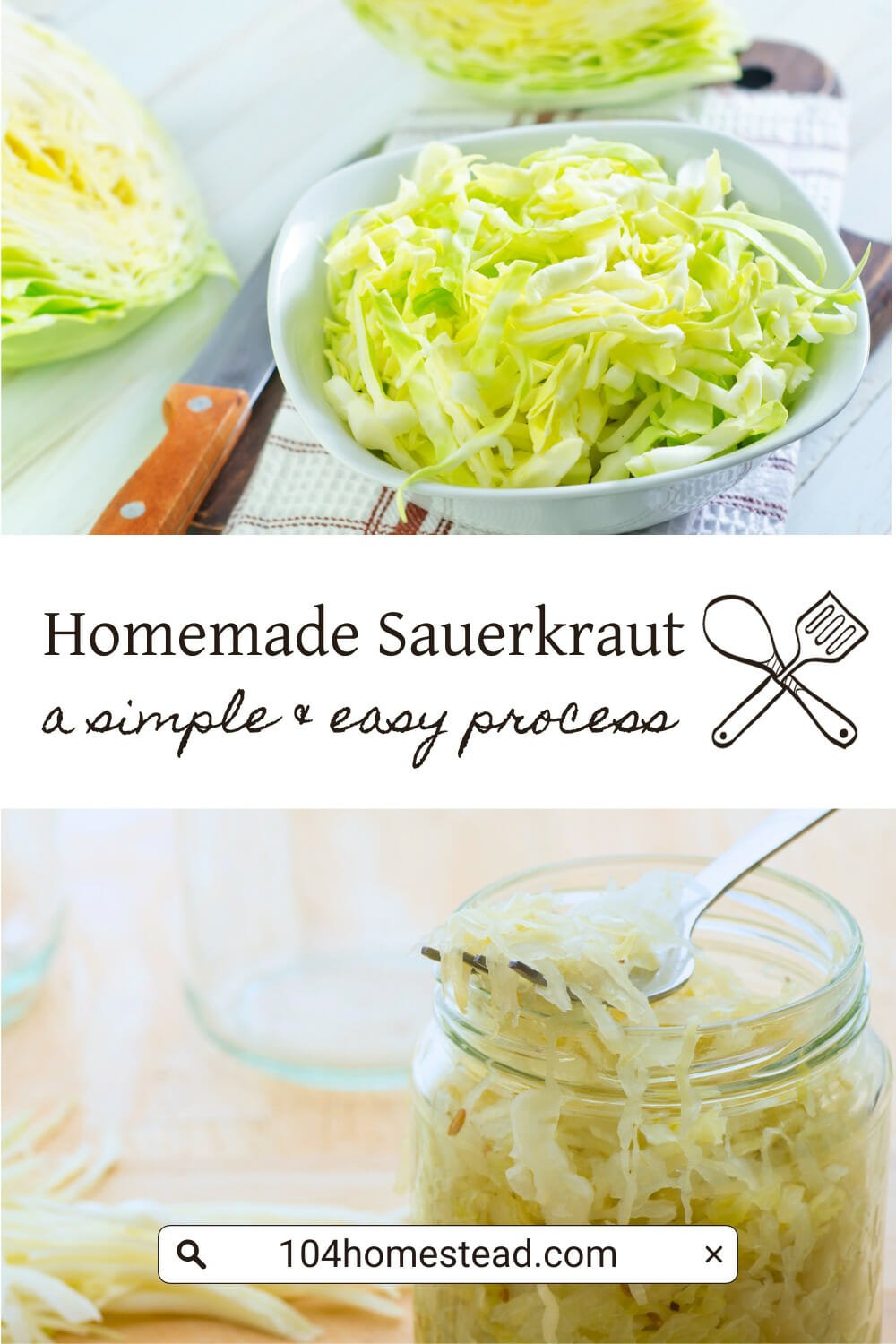
Making homemade sauerkraut is easier than you think! It’s a versatile ingredient that can be used in a variety of dishes. Some unique ways to incorporate sauerkraut into your recipes include sauerkraut soup, sauerkraut pancakes, sauerkraut pizza, or even sauerkraut-stuffed pierogies. You can also use sauerkraut as a topping for hotdogs, burgers, or bratwursts, or add it to sandwiches and wraps for a tangy kick. The possibilities are endless, so don’t be afraid to experiment and get creative in the kitchen.
Have you ever made homemade sauerkraut before? If so, what tips or tricks do you have to share? Share your thoughts and experiences in the comments below!
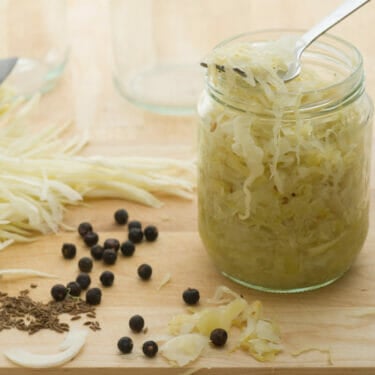
How To Make Homemade Sauerkraut in a Mason Jar
This post may contain paid links. If you make a purchase using the links in this recipe, I may earn a commission.
Equipment
- 1 Mason Jar quart-size
Instructions
- Wash and weigh your cabbage and write down the weight.1 Cabbage
- Peel off the outer leaves and cut out the cabbage core. Keep an extra outer leaf aside.
- Sprinkle your desired amount of salt over the cabbage and allow it to rest for 15 minutes.3-4 tsp Salt
- Massage cabbage for 5 minutes to release its liquid and create the brine.
- Fill the jar with approximately 4 to 5 handfuls of cabbage, pressing it down firmly to ensure a tight pack.
- Slowly and evenly pour the liquid from the bowl onto the cabbage in the jar, making sure that the cabbage is completely covered.
- Cut a circle out of the saved leaf from earlier, the same size as the opening of your jar. Place it directly on top of the shredded cabbage.
- Place the fermenting weight on top of the cabbage leaf, ensuring it is completely submerged in the liquid. Securely screw the lid onto your jar.
- Store the jars at 70-75° F while fermenting. The sauerkraut will be ready in 3 to 4 weeks at these temperatures.
- Remove the weight and round cabbage leaf when your sauerkraut is fermented to your desired taste and texture.
- After fermentation, ensure your sauerkraut is kept in a cool environment by storing the jar in the coldest part of the refrigerator.
